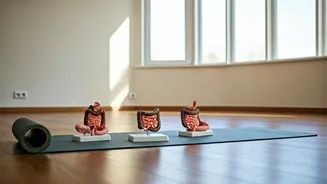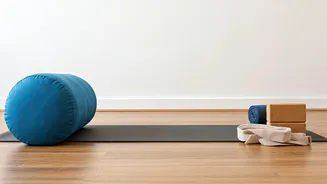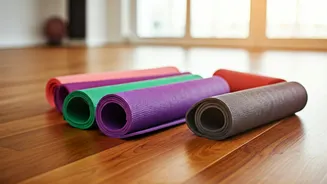Understanding Bloating And Gas
Bloating and gas often stem from various factors such as the foods we eat, the speed at which we eat, and even stress levels. Dietary choices play a significant
role; consuming foods high in fiber, such as beans and certain vegetables, can sometimes lead to increased gas production. Eating too quickly can cause us to swallow more air, contributing to bloating. Furthermore, stress and anxiety can impact our digestive processes, slowing them down and potentially causing discomfort. These conditions can also be related to underlying digestive issues, like Irritable Bowel Syndrome (IBS), or a simple imbalance in the gut flora. Understanding these causes is the first step towards finding effective relief, and that's where yoga can help.
Wind-Relieving Pose (Pavanamuktasana)
Pavanamuktasana, or the Wind-Relieving Pose, is a gentle yet effective posture for expelling trapped gas and easing bloating. To perform this pose, lie on your back with your legs extended. Bend your knees towards your chest and hug them tightly, clasping your hands just below the knees. Gently rock from side to side to massage the abdomen and stimulate digestion. Holding this pose for 30 seconds to a minute allows the pressure to ease the digestive tract. The gentle compression of the abdomen helps to release trapped air. If you feel any pain, adjust the position and the depth of the hug to maintain comfort. This pose is a great starting point for a yoga sequence focused on reducing bloating.
Child's Pose (Balasana)
Balasana, or Child's Pose, provides a soothing stretch that can calm the nervous system and ease digestive discomfort. Begin on your hands and knees, then bring your big toes to touch and spread your knees wide. Sit back on your heels and let your torso sink down between your thighs. Extend your arms forward or rest them alongside your body. This pose gently massages the abdominal organs, promoting relaxation and reducing bloating. Focus on deep, slow breaths to enhance the calming effects. Holding Balasana for 1-3 minutes can significantly relieve stress, which is often a contributor to digestive upset. The gentle compression helps to increase blood flow to the digestive organs, which in turn promotes better functionality.
Seated Spinal Twist (Ardha Matsyendrasana)
Ardha Matsyendrasana, or the Seated Spinal Twist, improves digestion by gently massaging the abdominal organs and stimulating peristalsis, which is the process that helps move food through the digestive system. Sit on the floor with your legs extended in front of you. Bend your right knee and place your right foot on the outside of your left thigh. Place your left hand on your right knee and your right hand behind you for support. Twist your torso to the right, looking over your right shoulder. Repeat on the opposite side. This twist aids in releasing trapped gas and improving overall digestive function. Performing the pose with slow, deliberate movements helps to deepen the benefits, supporting a more efficient digestive process. Remember to keep your spine long and avoid straining.
Supine Twist (Supta Matsyendrasana)
Supta Matsyendrasana, or the Supine Twist, is another beneficial pose to alleviate bloating and gas. Lie on your back with your knees bent and feet flat on the floor. Extend your arms out to the sides, palms facing down. Gently drop your knees to the right, keeping your shoulders flat on the floor. Turn your head to the left, allowing your gaze to fall in the opposite direction of your knees. Hold the pose for several breaths, focusing on deep, relaxing breaths. Then, return to the center and repeat on the other side. The gentle twist massages the abdominal organs, helping to release trapped gas and improve digestion. It also helps to stretch the spine and relieve any tension, promoting relaxation, which can also ease digestive issues.
Cobra Pose (Bhujangasana)
Bhujangasana, or Cobra Pose, helps stimulate the digestive organs and improve metabolism. Lie on your stomach with your hands under your shoulders. Keeping your elbows close to your body, gently lift your chest off the floor, using your back muscles. Do not push with your hands, and maintain a gentle curve in your lower back. Hold the pose for 15-30 seconds, breathing deeply. Cobra Pose improves digestion by stimulating the abdominal organs, which helps to ease discomfort associated with bloating. The gentle backward bend stretches the abdomen, promoting better digestion. Keep the shoulders relaxed and away from the ears to avoid unnecessary strain. Regular practice of this pose can improve digestive health and reduce bloating over time.
Bow Pose (Dhanurasana)
Dhanurasana, or Bow Pose, is another effective posture that stimulates the abdominal organs and boosts digestion. Lie on your stomach with your arms extended alongside your body. Bend your knees and reach back to grasp your ankles. Inhale and lift your chest and thighs off the floor, arching your back and creating a bow shape with your body. Hold this pose for 15-30 seconds, breathing deeply. The Bow Pose massages the abdominal organs, which aids in easing bloating and improving digestion. It also strengthens the back muscles, promoting better posture. Ensure that the posture is maintained by contracting the core muscles, thus reducing the risk of discomfort. Avoid overstretching and listen to your body to prevent injuries while holding the pose.
Bridge Pose (Setu Bandhasana)
Setu Bandhasana, or Bridge Pose, can also ease bloating and improve digestion. Lie on your back with your knees bent and feet flat on the floor, hip-width apart. Keep your arms alongside your body. Inhale and lift your hips off the floor, squeezing your glutes and thighs. Keep your chest lifted and your chin slightly tucked. Hold the pose for 30 seconds to a minute, breathing deeply. Bridge Pose stretches the abdomen, and this can help to improve circulation and stimulate digestion. It also strengthens the back muscles, which supports overall digestive health. Focus on keeping your core engaged and your shoulders relaxed to prevent strain. Maintaining deep, even breaths throughout the pose can maximize its benefits for digestive relief.
Standing Forward Bend (Uttanasana)
Uttanasana, or Standing Forward Bend, can help relieve bloating by gently compressing the abdomen and stimulating digestive processes. Stand with your feet hip-width apart. Inhale, then exhale as you bend forward from your hips, letting your torso hang towards your legs. If your hamstrings are tight, you can slightly bend your knees. Let your head hang heavy, and relax your neck. Holding this pose for 30-60 seconds can help soothe the abdominal area, facilitating the release of gas and supporting better digestion. Deep, steady breaths while in the pose are crucial. Ensure you do not strain your back while bending, and listen to your body's limitations to avoid discomfort. This posture is excellent for bringing immediate comfort to the digestive system.
Benefits Of Yoga & Bloating
Yoga offers numerous benefits for digestive health, helping to address the root causes of bloating and gas. Regular practice of these poses helps stimulate the digestive system, increasing blood flow and promoting the efficient breakdown of food. Furthermore, yoga postures can reduce stress and anxiety, which can have a significant impact on digestive function. By incorporating these poses into your daily routine, you can achieve long-term relief from bloating and other digestive issues. Combining these yoga practices with a balanced diet and other healthy habits can enhance your digestive health and overall well-being. The focus on mindful breathing and relaxation in yoga also helps regulate the nervous system, further supporting the reduction of digestive discomfort.



